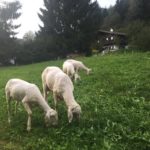
The village Vrouwenpolder
Vrouwenpolder is certainly a beautiful holiday destination. Due to its unique location among the dunes of the best sandy beaches of Walcheren, on Lake Veere with many water sports and in the immediate vicinity of forests (including the Manteling and protected water win-area Oranjezon) and pasture areas for hiking and biking. You can frequently encounter groups of deer.
 |
 |
 |
Vrouwenpolder combines a high level of facilities supermarkets, restaurants, hairdressers, restaurants, beach clubs, etc. with a pleasant rest for your well deserved holiday. The village has about 1100 inhabitants, is located directly behind the dunes of a 5 kilometer wide beach and country.
 |
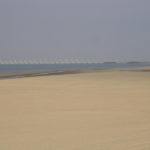 |
 |
Because of the space it is in the summer pleasantly busy without the impression of mass tourism. This makes Vrouwenpolder a popular location for the elderly. Ideal for families with young children is the wide safe sandy beach, in summer with day supervision by strand-guards.
 |
 |
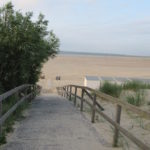 |
For varied excursions visit the historic cities of Veere and Middelburg. But also a day to Bruges or Ghent in Belgium lies within the possibilities.
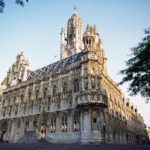 |
 |
 |
The History
The history of Vrouwenpolder is governed by the location. Vrouwenpolder is not the oldest village in North Walcheren. It originated in one of the polders that were formed by the reclamation of the marshes in the northeast of Walcheren.
After the reclamation of the marshes the area was called Niepolre, Nuwenpolre or Polre. In 1314 a chapel was founded, which becam in 1324 parish church, which allowed the residents to go in their own church instead of going to churches in Serooskerke and Zanddijk. The church was dedicated to Mary, known as Our Lady, hence the name Lady in the Polder, or Vrouwenpolder.
In the Middle Ages drew the village for another reason strange visitors. Vrouwenpolder was a place of pilgrimage. The Pilgrimages were initiated after the parish church in 1340 came in possession from a miraculous painting of Mary, the mother of Jesus. The panel was the focus of an annual procession on August 15, through the polder.
 |
 |
 |
The story goes that a painter in Middelburg was given the order, by the church, to make a painting of the Virgin Maria. A young apprentice came moments later and when he asked the painter for work, the painter gave him the blank panel. The companion went to the attic, but when the painter called him down for dinner, the young man was gone. The panel he had left was so masterfully painted that the painter and his family stood there amazed. The painter was convinced that the painting must have been created by an angel
The Lady of the Polder became a celebrity in her time. In 1437 Philip the Good was a guest in the village. Emperor Sigismund in 1461 together with Count William IV visited the painting.Furthermore, Our Lady of the Polder was especially revered by Spanish, Portuguese and Breton sailors. After the Reformation began the panel on a tour. It ended up in Bruges and in 1931, following a donation of Baron Caloen back on Walcheren, to the Roman Catholic Church in Middelburg.
 |
 |
 |
Vrouwenpolder got together with Veere in 1349 freedom of toll from Duke William of Bavaria, a privilege that only had Walcheren Westkapelle and Westhove.
In 1452 Henry of Borssele moved the monastery of the Holy Sepulchre Mortiere to Vrouwenpolder. In 1552 the monastery was abolished by Maximilian of Burgundy and the buildings were sold. During the siege of Middelburg the entire village, including the monastery and church were destroyed. In 1611 the village got a reformed church, and seven years later a minister. The ruined church was rebuilt in 1624 and was finished.
Fort den Haak
Northeast of Vrouwenpolder Fort den Haak was built in 1588, to control the entrance from the sea to the Veerse Gat. The fort was situated at the entrance to the Veer Gat and the North Sea, so at the junction of two important strategic shipping lanes.
In the Eighty Years’ War, which was in progress, the Spanish got to shore at the Fort to supply food to the village intended for the beleaguered Middelburg.
When the British attacked Walcheren from the north, in the French period in 1809, they could take the fortress, which was then destroyed.
 |
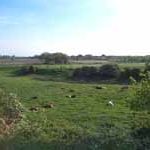 |
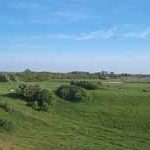 |
Fort den Haak is a small nature reserve with dunes, ponds, grasslands and thickets. It is located on the site of the former fort Fort den Haak, built as a defense against possible Spanish landings on the north coast of Walcheren. In the area are salty and sweet parts. On the salty parts are salt-loving plants such as aquamarine sea rushes and sedge present. In addition, the area is known for its orchids, carline thistle and rare mushrooms as Plompe mushroom, special are the pieces of quaking moor. There is a small gull colony and in the hawthorn and elderberries are breeding nightingales, stonechat and warblers. The turtle dove is still here.
From 1816 to 1966 Vrouwenpolder was an independent municipality, which included Breezand, Zanddijk Buiten, Schellach and Gapinge (from 1857). After that time Vrouwenpolder went on in the municipality of Veere. Since the Veerse Gat closed and tourism got underway, the village attracts holidaymakers and day trippers.
Vrouwenpolder owes its current fame to the wide, five kilometers long North Sea beaches and the Veerse Lake. Each year 385,000 people stay in the village, about 333 times the number of inhabitants.
|




